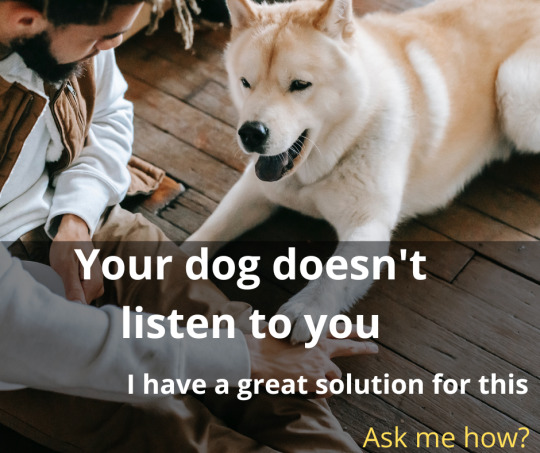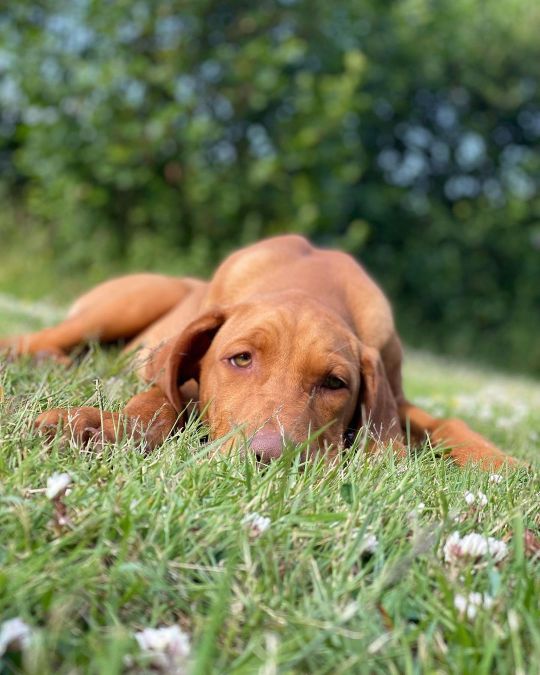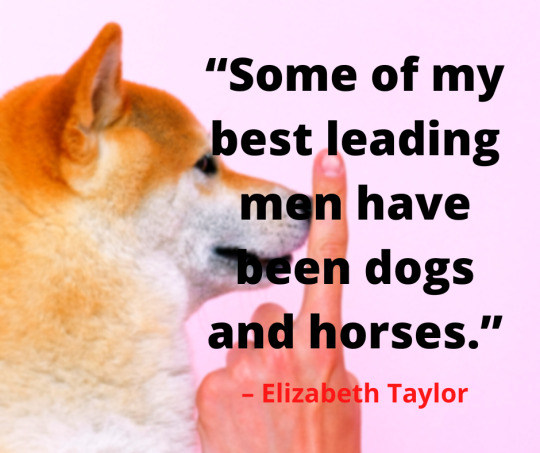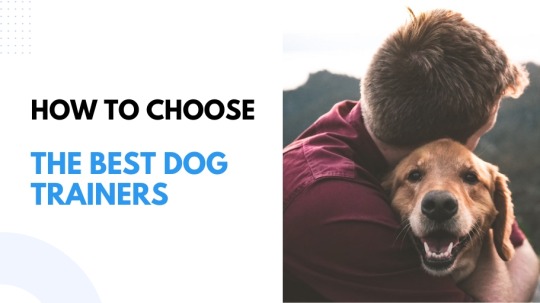#dogtrainer
Text
Solving Dog Problems

Have you ever been enjoying a walk with your dog when suddenly you are almost tripped by Fido or Fifi unexpectedly crossing in front of you? Not only is it unpleasant, but crossing in front of you like this is dangerous for both you and your dog. Luckily it is fairly easy to teach your dog to stay on one side of you and not to switch sides.
I feel that it is works best to teach your dog leash manners when using a 6 foot leash (not a Flexi-type) and a no-pull harness if your dog pulls.
The first thing to do is decide which side of you that you would like your dog to walk. Then, as your dog is walking on the leash reward him any time he happens to be on your chosen side by saying "yes" or "good" and feeding him a treat right by your side.
Be very careful to feed the treat by your side and not to feed the treat in front of you as that will encourage crossing in front.
While walking your dog, be careful to watch him, and as soon as he starts to cross in front of you, use your leash to prevent him from crossing, and stomp your feet to make your presence known.
Consistently rewarding your dog for being on your preferred side and preventing him from crossing in front by using the leash and by stomping your feet should help teach your dog to stop crossing in front of you and lead to safer and more pleasant walks. Enjoy!
Click here for more ---Click here tips on training
#dogtrainer#dogtraining#zakgeorge#dogtrainingrevolution#positivedogtraining#balanceddogtraining#forcefreedogtraining#dogtraining101#puppytraining#puppytrainingadvice#puppytrainingtips#puppytraining101#realitydogtraining#dogtrainingadvice#dogtrainingtips#howtotrainyourdog#dogsofinstagram#dogstagram#ilovemydog#dog#dog training#cute dog#doglover#doglife
2 notes
·
View notes
Photo

This training is hard work!! #hungarianvizsla #hungarianvizslapuppy #rebelritsigundogs #hungarianvizsla #gundogtrainer #gundogtrainerkent #gundogtrainerinkent #gundogtrainingkent #gundogtraininginkent #cwnsaethugundogtraining #gundogtraining #gundog #springerspaniel #gundogs #gundogtrainingjourney #gundogoftheday #dogtraining #dogtrainer #dogtrainerslife #dogtrainingtips #dogtraining101 #dogtrainers #huntpointretrieve #spaniels #retrievers #placeboardtrainingforgundogs #cwnsaethugundogs #cwnsaethugundogtraining #trainthedoginfrontofyou @rebelritsigundogs #accreditedpetgundoginstructor #gundogsofinstagram https://www.instagram.com/p/CfKb5nTL18J/?igshid=NGJjMDIxMWI=
#hungarianvizsla#hungarianvizslapuppy#rebelritsigundogs#gundogtrainer#gundogtrainerkent#gundogtrainerinkent#gundogtrainingkent#gundogtraininginkent#cwnsaethugundogtraining#gundogtraining#gundog#springerspaniel#gundogs#gundogtrainingjourney#gundogoftheday#dogtraining#dogtrainer#dogtrainerslife#dogtrainingtips#dogtraining101#dogtrainers#huntpointretrieve#spaniels#retrievers#placeboardtrainingforgundogs#cwnsaethugundogs#trainthedoginfrontofyou#accreditedpetgundoginstructor#gundogsofinstagram
7 notes
·
View notes
Text

Best. Job. Ever.
2 notes
·
View notes
Text
“Dogs do speak, but only to those who know how to listen.”
#dogtraining#dogsofinstagram#dog#dogs#dogtrainer#k#puppy#dogstagram#doglife#doglover#dogoftheday#doglovers#puppytraining#training#instadog#workingdog#puppylove#dogtrainingtips#dogsofinsta#puppiesofinstagram#dogphotography#germanshepherd#happydog#doggo#dogslife#obediencetraining#puppies#instagram#love#gsd
2 notes
·
View notes
Text
Puppy Needs New Food!

Here are the most critical things to look for when shopping for your puppy's food.
Michael Pollan, author of the best-selling books on diet The Omnivore’s Dilemma, In Defense of Food, and Food Rules, once came up with the world’s most succinct guide for a healthy human diet: “Eat food. Not too much. Mostly plants.”
If only we could come up with something that simple for puppies! The advice could start in a very similar fashion: “Feed food. Not too much….” But in order for the slogan to be nutritionally sound, the next part would be far too complicated to put on a book cover or tote bag: “Mostly quality sources of animal protein, delivered at adequate levels. Same goes for fat. Not too much calcium, but enough, depending on the expected adult size of the puppy . . . .”
There’s more, but you get the idea. There are a lot of factors that have to be carefully considered when feeding puppies – that is, if you want them to grow into healthy and sound adult dogs.
On the other hand, I don’t want to scare anyone; feeding puppies isn’t rocket science. But there are a few little details that you need to attend to in order to make sure your pup grows at an appropriate rate – things that aren’t as critical with an adult dog.
STANDARD ISSUE
The differences between the nutrient requirements for puppies and those for adult dogs are laid out in tables developed by the Association of American Feed Control Officials (AAFCO); these are called the AAFCO Dog Food Nutrient Profiles, and they include the standards for what comprises the legal definition of “complete and balanced” diets for dogs. One lists the nutrient levels required for the “maintenance” of adult dogs only; the other lists the nutrient levels that meet the needs of breeding animals, pregnant or nursing females, and growing puppies. The latter is often referred to as the “growth and reproduction” nutrient profile.
These tables differ in notable ways. Puppies need higher amounts of protein (including higher amounts of many specific amino acids that contribute to the food’s total protein), fat, calcium, phosphorus, and several other minerals than the amounts needed by adult dogs. This is why you must make sure that the food you buy for your puppy (any dog less than a year old) is formulated to meet the standards for complete and balanced nutrition for growth.
Often, dog food labels say that the food contained in the package meets the standards for dogs “of all life stages.” This implicitly includes puppies. If a food is labeled as either meeting the nutrient levels or passing a feeding trial for dogs of “all life stages,” it has to meet the “growth” requirements.��
Often – but not always – food that is formulated to meet the needs of puppies has the word “puppy” in the name of the food. Again, if the label indicates that it’s “complete and balanced for dogs of all life stages,” it has met the AAFCO standards for growth (puppies). But if the label says it is “complete and balanced for adult maintenance,” it is not suitable for puppies.
Where will you find this information? This is where things get weird: This statement is the most important thing to check on the label of your puppy’s food, and I will almost guarantee that it will be printed on the bag or can in teeny, tiny type. Scan the label carefully for the words “AAFCO Nutrient Profiles” or “AAFCO Feeding Trial.” The block of text containing one of these phrases will probably appear on the back or even the side of the package, and it will reference either “growth” (great!), “dogs of all life stages” (super!), or “adult maintenance” (womp, womp, no!).
CHECK THE SIZE
All puppy foods used to be formulated to meet the same nutrient standards. In recent years, however, animal nutrition experts came to understand that large-breed puppies should receive less calcium than puppies of smaller breeds to prevent their bones from growing too quickly. Excessively fast growth can result in the development of bone and joint abnormalities in large-breed puppies. So, in 2016, AAFCO began to require food makers to explicitly state whether their products contained calcium at an appropriate level for large breed puppies (defined as those pups expected to reach an adult weight of more than 70 pounds).
If the AAFCO statement says the food is for growth/all life stages “including growth of large-size dogs (70 pounds or more as an adult),” it is safe to feed to large breed pups.
If the statement says the food is for growth/all life stages “except for growth of large-size dogs (70 pounds or more as an adult),” it should not be fed to large-breed puppies.
To be safe, if you have a large-breed puppy, or a mixed-breed pup who looks like he may grow to more than 50 or 60 pounds, you should choose foods with the “including growth of large-size dogs” statement. Smaller-breed puppies can be safely fed foods with either statement.
OUR USUAL CRITERIA
Once you are confident that you can identify foods that are appropriate for puppies of the size you expect your pup to be, you can search among those products for diets that meet our usual selection criteria (listed in the box below) and that are in your price range.
Check the protein and fat content of the food you are feeding your pup right now. If his weight and energy are good, try to buy only those foods that contain similar levels of protein and fat. Be aware that these levels range widely. If you start feeding him a product with double or half the protein or fat content of the food you are giving him now, you will see changes in him; his appetite, weight, stool quality, and/or energy may be affected.
Finally, don’t be afraid to try different foods. Pet food companies want to win your loyalty, but the fact is, variety is actually good for your puppy. The more you change foods, the more accustomed his digestive tract will become to a wide variety of ingredients. Also, because each manufacturer’s products contain different levels of each required nutrient (within the AAFCO specifications), by routinely switching products, you are sure to provide “balance over time” and prevent him from suffering ill effects of any potentially excessive or deficient nutrient levels.
LEARN MORE CLICK HERE
4 notes
·
View notes
Text
Dog Training: Obedience Training for Dogs
How Should You Train Your Dog?
There are two common methods of training a dog.
The first is the aversive-based method. The second is the reward-based method. Aversive-based (discipline) training is when you use positive punishment and negative reinforcement techniques with your dog. Reward-based methods use rewards only for the behaviors that you want your dog to follow.
Aversive-based training uses techniques like loud, unpleasant noises, physical corrections, and harsh scoldings to get your dog to act the way you want. On the other hand, reward-based training uses rewards whenever your dog does something you want it to do. Treats, belly rubs, or other dog-pleasing actions are used to reinforce that a behavior was good.
Different experts prefer one method over the other. The one that you use is completely up to you.
Some people believe that a rewards-based method sets up an "event sequence" for your dog where they associate you with happy feelings when they do what they're told. Aversive-based methods do just the opposite, where they fear you. That fear means that your dog does what they are told to avoid unpleasant feelings.
Understand How Your Dog Learns
Dogs learn a lot like little kids. They are close in intelligence to human two-year-olds. Immediate consequences are all that they care about. As they grow, they begin to understand our words. Some intelligent breeds will respond to as many as 250! Yet every dog responds to the tone of our voice more than the actual words.
There are three types of dog intelligence recognized by scientists:
Instinctive
Adaptive
Working and obedience
Instinctive learning is when your dog learns the behaviors they were bred. Adaptive learning is how well your dog learns from their surroundings and the environment around them to solve problems. Working and obedience are how well they learn the tasks and commands that you teach them.
To get your dog to be obedient, you should focus on training that uses obedience techniques and the specific behaviors you want from them. Both aversive- and reward-based training have been proven to work. However, if you’re training your dog to be a loving pet, you should consider reward-based obedience training. This method doesn’t develop fear-based responses in your dog. It actually reinforces your loving relationship with them.
Obedience Training Rewards
Dogs are smart enough to learn the behaviors that you want them to have. They are also smart enough to learn what they can get away with.
If you're wondering how to train a dog with a specific behavior, one of the most effective methods is to give them treats, praise, or affection. Most importantly, the best reward to give them is the one that they want the most. If they are food motivated, treats might work better than praise. If they crave attention from you, then affection might be the best reward.
The main point to focus on is to consistently give your dog rewards for the behavior that you want. Do not reward the behavior you don’t want. When your dog performs the behavior, they should get their reward. If you ask them to lie down and don’t give them a treat until they stand back up, they become confused. They won’t know which behavior the reward was for.
Click here:- https://bit.ly/3OBX2yT
#dogtraining#dogsofinstagram#dog#dogs#dogtrainer#k#puppy#dogstagram#doglife#doglover#dogoftheday#doglovers#puppytraining#training#instadog#workingdog#puppylove#dogtrainingtips#dogsofinsta#puppiesofinstagram#dogphotography#germanshepherd#happydog#doggo#dogslife#obediencetraining#puppies#instagram#love#gsd
5 notes
·
View notes
Text
Dog Training Session for Pet Parents in Pune

Struggling with your pup's behavior? Mr n Mrs Pet offer Dog Training Sessions for Pet Parents in Pune! We help with obedience, unwanted behaviors, guard training, and even housetraining puppies. Our personalized sessions cater to your pet's needs, ensuring a happy, well-behaved dog and a stress-free you! Book your consultation today!
#dogtraining#dogsofinstagram#dog#dogs#dogtrainer#k#puppy#dogstagram#doglife#doglover#dogoftheday#doglovers#puppytraining#training#instadog#workingdog#puppylove#dogtrainingtips#dogsofinsta#puppiesofinstagram#dogphotography#germanshepherd#happydog#doggo#dogslife#obediencetraining#puppies#instagram#love#gsd
1 note
·
View note
Text
Puppy Biting 101🦈🦷
#DogTraining#puppy#puppytips#dogtrainer#dogsoftiktok#fyp#viral#puppytraining#puppybiting#puppyadvice#stoppuppybiting#howtostopapuppyfrombiting#howtostopadogfrombiting#trainingpuppynottobite#howtostoppuppybiting#howtotrainapuppynottobite#howtotrainyourdognottobark#cratetrainingapuppy#howtostopdogfrombiting#howtogetapuppytostopbiting#howtotrainadognottobark#dogjumping#dogstop#barkingdogs#dogbehaviour#dogbarking#howtostopadogfromchewing#dogtraining#teachingapuppynottobite#howtostopmydogfrombiting
1 note
·
View note
Text
New Puppy? Training vs Trainer

Training a new puppy is an important and rewarding responsibility. Here are the top 10 considerations to keep in mind:
Socialization: Early socialization is crucial for a puppy’s development. Expose your puppy to various people, animals, environments, and experiences in a positive and controlled manner to build their confidence and reduce anxiety in different situations read more here
0 notes
Text
Special Dog Walking Service in Orinda
If you're in Orinda and searching for a dog walking service that truly understands and cares for your pet, look no further than Diablo Dog Walking in Orinda. Download the Doc for more info.
#dogtraining#dogwalking#dogtrainer#dogwalkingservices#dog trainer#dog walkers#dog walking#dog walker Orinda#Orinda
0 notes
Text
My wife's service dog in training, Matilda, is trained to be super annoying at specific times of day. This is because my wife's executive dysfunction does not allow her to 'unfreeze' and therefore she gets 'stuck' in places/doing things long after she needs to move on to another task, room, etc. This isn't some arbitrary 'you should only play video games so long' type of thing. It's 'If unattended, my wife will not eat or sleep because moving from one thing to another is very hard'. Eating and sleeping are necessary things for survival, so moving to these tasks is necessary for survival.
Matilda has therefore been taught things like 'ten pm is bedtime'. In order to help Matilda with this, her feeding schedule is on a pretty tight timeline as well--this way her internal body cues are lined up with the schedule of the day. For example, Matilda is fed between 8 and 830 pm (usually at about 810 pm, as it works out). She poops at 830 pm after dinner and she will throw a WHOLE FIT if she is not let out at this time.
Daylight Savings has Happened to Matilda. She's only just a year old, so she does not remember Daylight Savings last year (she was two weeks old, roughly) and she does not remember the spring time change, either, as she was a fairly young puppy at that time and therefore not trained to a schedule like this.
She is BEREFT. We're making her wait an hour for dinner. We're making her wait an hour for bedtime. She knows she needs to go out at 830, but it is not time for her to poop yet, which is BAFFLING.
This poor dog. I'm sure she'll adjust in a week or two, but poor Matilda.
We need to outlaw Daylight Savings. For Matilda.
10K notes
·
View notes
